[English] 日本語
 Yorodumi
Yorodumi- PDB-7adz: Cryo-EM structure of an extracellular contractile injection syste... -
+ Open data
Open data
- Basic information
Basic information
| Entry | Database: PDB / ID: 7adz | ||||||||||||
|---|---|---|---|---|---|---|---|---|---|---|---|---|---|
| Title | Cryo-EM structure of an extracellular contractile injection system in marine bacterium Algoriphagus machipongonensis, the cap portion in extended state. | ||||||||||||
 Components Components |
| ||||||||||||
 Keywords Keywords | STRUCTURAL PROTEIN / extracellular contractile injection system | ||||||||||||
| Function / homology |  Function and homology information Function and homology information | ||||||||||||
| Biological species |  Algoriphagus machipongonensis (bacteria) Algoriphagus machipongonensis (bacteria) | ||||||||||||
| Method | ELECTRON MICROSCOPY / single particle reconstruction / cryo EM / Resolution: 2.5 Å | ||||||||||||
 Authors Authors | Xu, J. / Ericson, C. / Feldmueller, M. / Lien, Y.W. / Pilhofer, M. | ||||||||||||
| Funding support |  Switzerland, 3items Switzerland, 3items
| ||||||||||||
 Citation Citation |  Journal: Nat Microbiol / Year: 2022 Journal: Nat Microbiol / Year: 2022Title: Identification and structure of an extracellular contractile injection system from the marine bacterium Algoriphagus machipongonensis. Authors: Jingwei Xu / Charles F Ericson / Yun-Wei Lien / Florentine U N Rutaganira / Fabian Eisenstein / Miki Feldmüller / Nicole King / Martin Pilhofer /    Abstract: Contractile injection systems (CISs) are phage tail-like nanomachines, mediating bacterial cell-cell interactions as either type VI secretion systems (T6SSs) or extracellular CISs (eCISs). ...Contractile injection systems (CISs) are phage tail-like nanomachines, mediating bacterial cell-cell interactions as either type VI secretion systems (T6SSs) or extracellular CISs (eCISs). Bioinformatic studies uncovered a phylogenetic group of hundreds of putative CIS gene clusters that are highly diverse and widespread; however, only four systems have been characterized. Here we studied a putative CIS gene cluster in the marine bacterium Algoriphagus machipongonensis. Using an integrative approach, we show that the system is compatible with an eCIS mode of action. Our cryo-electron microscopy structure revealed several features that differ from those seen in other CISs: a 'cap adaptor' located at the distal end, a 'plug' exposed to the tube lumen, and a 'cage' formed by massive extensions of the baseplate. These elements are conserved in other CISs, and our genetic tools identified that they are required for assembly, cargo loading and function. Furthermore, our atomic model highlights specific evolutionary hotspots and will serve as a framework for understanding and re-engineering CISs. | ||||||||||||
| History |
|
- Structure visualization
Structure visualization
| Movie |
 Movie viewer Movie viewer |
|---|---|
| Structure viewer | Molecule:  Molmil Molmil Jmol/JSmol Jmol/JSmol |
- Downloads & links
Downloads & links
- Download
Download
| PDBx/mmCIF format |  7adz.cif.gz 7adz.cif.gz | 1.4 MB | Display |  PDBx/mmCIF format PDBx/mmCIF format |
|---|---|---|---|---|
| PDB format |  pdb7adz.ent.gz pdb7adz.ent.gz | Display |  PDB format PDB format | |
| PDBx/mmJSON format |  7adz.json.gz 7adz.json.gz | Tree view |  PDBx/mmJSON format PDBx/mmJSON format | |
| Others |  Other downloads Other downloads |
-Validation report
| Summary document |  7adz_validation.pdf.gz 7adz_validation.pdf.gz | 928.9 KB | Display |  wwPDB validaton report wwPDB validaton report |
|---|---|---|---|---|
| Full document |  7adz_full_validation.pdf.gz 7adz_full_validation.pdf.gz | 971.8 KB | Display | |
| Data in XML |  7adz_validation.xml.gz 7adz_validation.xml.gz | 183.4 KB | Display | |
| Data in CIF |  7adz_validation.cif.gz 7adz_validation.cif.gz | 284.6 KB | Display | |
| Arichive directory |  https://data.pdbj.org/pub/pdb/validation_reports/ad/7adz https://data.pdbj.org/pub/pdb/validation_reports/ad/7adz ftp://data.pdbj.org/pub/pdb/validation_reports/ad/7adz ftp://data.pdbj.org/pub/pdb/validation_reports/ad/7adz | HTTPS FTP |
-Related structure data
| Related structure data |  11734MC  7ae0C  7aebC  7aefC  7aekC M: map data used to model this data C: citing same article ( |
|---|---|
| Similar structure data |
- Links
Links
- Assembly
Assembly
| Deposited unit | 
|
|---|---|
| 1 |
|
- Components
Components
| #1: Protein | Mass: 22981.086 Da / Num. of mol.: 6 / Source method: isolated from a natural source / Details: cap protein (Algo1) / Source: (natural)  Algoriphagus machipongonensis (bacteria) / References: UniProt: A3HTC4 Algoriphagus machipongonensis (bacteria) / References: UniProt: A3HTC4#2: Protein | Mass: 33083.371 Da / Num. of mol.: 6 / Source method: isolated from a natural source / Details: cap adaptor protein (Algo2) / Source: (natural)  Algoriphagus machipongonensis (bacteria) / References: UniProt: A3HTC3 Algoriphagus machipongonensis (bacteria) / References: UniProt: A3HTC3#3: Protein | Mass: 16375.458 Da / Num. of mol.: 12 / Source method: isolated from a natural source / Source: (natural)  Algoriphagus machipongonensis (bacteria) / References: UniProt: A3HTC1 Algoriphagus machipongonensis (bacteria) / References: UniProt: A3HTC1#4: Protein | Mass: 76319.039 Da / Num. of mol.: 6 / Source method: isolated from a natural source Details: the residues (288-320aa) are not built up in the model and the residues (430-446aa) are assigned as poly-alanine due to the poor density map. Source: (natural)  Algoriphagus machipongonensis (bacteria) / References: UniProt: A3HTC2 Algoriphagus machipongonensis (bacteria) / References: UniProt: A3HTC2 |
|---|
-Experimental details
-Experiment
| Experiment | Method: ELECTRON MICROSCOPY |
|---|---|
| EM experiment | Aggregation state: PARTICLE / 3D reconstruction method: single particle reconstruction |
- Sample preparation
Sample preparation
| Component | Name: The cap portion of an extracellular contractile injection system in marine bacterium Algoriphagus machipongonensis Type: COMPLEX / Entity ID: all / Source: NATURAL |
|---|---|
| Source (natural) | Organism:  Algoriphagus machipongonensis (bacteria) Algoriphagus machipongonensis (bacteria) |
| Buffer solution | pH: 8 |
| Specimen | Embedding applied: NO / Shadowing applied: NO / Staining applied: NO / Vitrification applied: YES |
| Specimen support | Grid material: GOLD / Grid mesh size: 200 divisions/in. / Grid type: Quantifoil |
| Vitrification | Instrument: FEI VITROBOT MARK IV / Cryogen name: ETHANE-PROPANE |
- Electron microscopy imaging
Electron microscopy imaging
| Experimental equipment |  Model: Titan Krios / Image courtesy: FEI Company |
|---|---|
| Microscopy | Model: FEI TITAN KRIOS |
| Electron gun | Electron source:  FIELD EMISSION GUN / Accelerating voltage: 300 kV / Illumination mode: FLOOD BEAM FIELD EMISSION GUN / Accelerating voltage: 300 kV / Illumination mode: FLOOD BEAM |
| Electron lens | Mode: BRIGHT FIELD |
| Image recording | Electron dose: 60 e/Å2 / Film or detector model: GATAN K3 (6k x 4k) |
- Processing
Processing
| CTF correction | Type: PHASE FLIPPING AND AMPLITUDE CORRECTION |
|---|---|
| 3D reconstruction | Resolution: 2.5 Å / Resolution method: FSC 0.143 CUT-OFF / Num. of particles: 65059 / Symmetry type: POINT |
| Atomic model building | Protocol: AB INITIO MODEL / Space: REAL |
 Movie
Movie Controller
Controller




















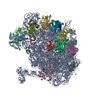
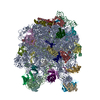

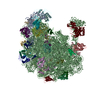

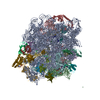
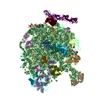

 PDBj
PDBj